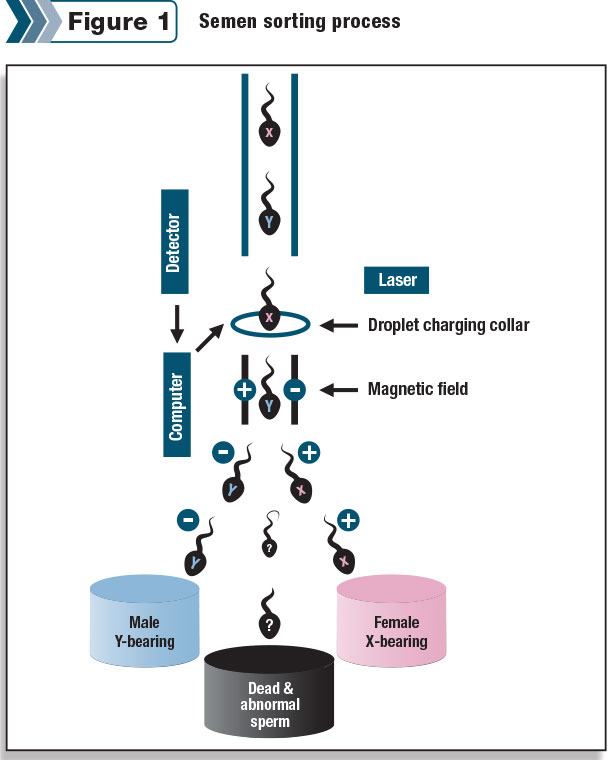The ability to actively choose the gender of the calf to be born is now a reality on dairy farms. Indeed, the last 10 years have seen rapid evolution in semen-sexing technologies.
When sexed semen first became commercially available, sales were slowed by high prices due to the cost of the sorting process, conception rates about 25 percent lower than those achieved through using conventional semen and because it was available only from bulls with low genetic values.
Just as the analog phone gave way to today’s digital smartphones, the advancing science behind sex-sorting semen over the past decade has ushered in technological advances that have resulted in a lower-cost product that offers conception rates rivaling those achieved using conventional semen. Now gender selection using sexed semen from genetically elite bulls is a leading tool in the modern dairyman’s strategic herd management kit.
One of the major improvements to the sex-sorting process in the past few years is the elimination of a significant amount of waste in the semen, including dead and abnormal cells and impurities in the ejaculate. Today’s sexed semen emerges from the sorting process containing sperm of an unprecedented purity, motility and viability, thus optimizing fertilization.

Improvements have also been made to the sorting machines, the software that runs them and the media that nourishes and invigorates sperm cells. These advancements have resulted in lower sorting costs and contributed to higher conception rates than earlier sexed semen.
Several important results have come from recent advancements in sex-sorting technology:
-
Significant improvement in pregnancy rates: Studies show a 75 percent improvement in pregnancy rates. Certain sexed semen, packed at about 2 million cells per straw, has been found to have conception rates up to 90 percent of those achieved using conventional semen straws.
More impressively, a 2015 field trial on 45,000 cows in Germany found that A.I. using this particular sexed female semen, packed 4 million cells per straw, achieved conception rates identical to conventional semen packed 15 million cells per straw.
-
Accelerated genetic gains with the availability of sexed semen from elite bulls: The approach to selling sexed semen has flipped completely since it was first offered. The majority of sexed semen on the market today comes from genetically elite bulls, resulting in overall improvement of herd genetics.
Using sexed semen from elite bulls on the top genetic heifers in a herd will result in replacement calves with the best potential to be profitable in the future.
-
Greater milk production for cows birthing heifers: Dairy farmers have long known that cows delivering heifer calves experience fewer birthing complications than those delivering bull calves, but an evolutionary biologist at Harvard University discovered that cows carrying heifer calves produce more milk than those delivering bull calves.
In a study released in 2014, Katie Hinde looked at 2.5 million lactations of 1.5 million dairy cows and determined that cows giving birth to two consecutive heifer calves produced up to 1,000 pounds (454 kilograms) more milk over the two lactations than did cows that had two bull calves or those that had one calf of each gender.
Among cows delivering a calf of each gender, those that had a heifer calf first produced more milk than did those delivering a bull calf first.
- A way to expand the dairy herd: This technology ensures a sufficient supply of females within the herd and virtually eliminates a breeder’s need to buy new heifers. Producing replacement heifers in-house reduces a dairyman’s cash outflow and decreases health risks created by bringing in new animals from outside herds, thus increasing herd biosecurity.
Previously advocated for use only on heifers, this new technology is now used on heifers and primiparous or multiparous cows. That said, it is recommended to limit its use to the first or second insemination. After this stage, the economic impact associated with longer open days could penalize too heavily the interval between calvings.
Considering again the herd fertility as one of the most sensitive to external influence, it is certain all of the nutritional and health parameters must be controlled to expect satisfactory pregnancy rates. The latter can be achieved following the insemination after either natural or heat synchronization protocols. Embryo collections and ovum pick-up/in vitro fertilization can now also be practiced with confidence using sexed semen.
To achieve optimum conception rates, follow these recommendations:
- Delay insemination by four to six hours when compared to conventional semen practice. Insemination with sexed semen should occur 16 hours to 18 hours after observing standing heat.
- Thaw semen for a minimum of 45 seconds.
- Thaw semen at a temperature of 95ºF to 98.6ºF.
- Inseminate within five minutes after thawing.
- Disinfect the thaw unit on a weekly basis.
Gender determination was long held as the holy grail of the dairy industry and, since its inception, has focused on creating females. But the technology also offers dairymen an opportunity to utilize sexed male semen as part of an innovative management program. After creating the desired number of female pregnancies in the top animals, a dairyman can use sexed male semen from crossbreeding beef sires to produce a valuable market calf.
Today’s sexed semen, with its lower cost and comparable conception rates to conventional semen, provides modern dairy producers the genetics they want in the daughters they need to make their operations successful and profitable. Just as important, it allows them to be proactive herd managers who are no longer limited by the whims of nature. PD
PHOTO: Now, gender selection using sexed semen from genetically elite bulls is a leading tool in the modern dairyman’s strategic herd management kit. Photo provided by TAG-Sexing Technologies ULC.
References omitted but are available upon request. Click here to email an editor.
Julien Thomin is the Canadian sales director for TAG-Sexing Technologies ULC. Email Julien Thomin.






